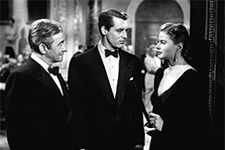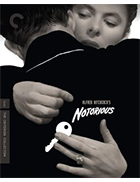Notorious
|  Notorious is the best of Alfred Hitchcock’s espionage thrillers and one the strongest works of his extensive cinematic career. In his book Hitchcock’s Films Revisted, Robin Wood described it as “one of Hitchcock’s finest works,” and François Truffaut, in his interviews with Hitchcock, professed that it “is truly my favorite Hitchcock picture ... In my opinion, Notorious is the very quintessence of Hitchcock.” One of the things that makes Notorious “the very quintessence of Hitchcock” is how effectively it creates an exhilarating surface of romance and intrigue that barely disguises its true underlying concerns. Written by prolific screenwriter Ben Hecht (a frequent collaborator with producer David O. Selznick) in close collaboration with Hitchcock, it is ostensibly a spy movie about infiltrating a ring of Nazi agents in Brazil. And, while Notorious deals on the surface with classic themes such as love versus duty (a common subject in movies made during World War II), it is really about the hypocrisies of gendered social codes and mores. Ingrid Bergman, having just starred in Hitchcock’s Spellbound (1945), plays the central role of Alicia Huberman, the “tainted” daughter of a convicted Nazi spy. I describe Bergman’s role as “central” despite Cary Grant, as a U.S. agent named Devlin, getting top billing. While Notorious has been viewed by many as another of Hitchcock’s films in which male identification dominates, I am in firm agreement with Robin Wood’s argument that the film, in fact, employs a female identification system in which we as viewers most thoroughly identify with Alicia. She is the central character about whom we care the most; she is the most sympathetic and engaging person on-screen. Hitchcock brings us into identification with Alicia in the film’s opening moment when she is swarmed by reporters asking questions and flashing cameras in her face as she leaves her father’s trial. Alicia is a complex woman, and her “tainted” status derives not only from her familial connections to Nazism, but also from rumors about her “unladylike” behavior, particularly her loose sexuality and heavy drinking. Bergman’s performance is crucial here, as she portrays Alicia as a woman who uses cynicism and alcohol to mask her pain and sadness. She purposefully flaunts the social codes that define “womanly behavior” not out of a feminist edict, but because she has simply stopped caring. She is a woman in despair, which makes her vulnerable and, in Hitchcock’s frame, ultimately sympathetic. Alicia is convinced by the U.S. government to go to Brazil to infiltrate a ring of Nazi agents who are hiding there after the war. Her contact is Devlin, and although they are at first antagonistic, they quickly fall in love. That romance is complicated when Alicia discovers that her mission involves infiltrating the Nazis by sleeping with and eventually marrying Alexander Sebastian (Claude Rains), one of her father’s former associates who uses his enormous house as a base for Nazi scientific activities. If this were a conventional male-dominated narrative, the story would focus on the ramifications of Devlin having to subsume his romantic interests in Alicia to his professional and patriotic duty to push her into another man’s bed for the good of the country. But, crucially, the movie focuses on Alicia’s need to sacrifice both body and soul because, after all, until the final moments, she is the one in danger, not the male government agents who mostly sit around hotel rooms monitoring the situation from a safe distance. The majority of the film takes place in Rio de Janeiro, as Alicia works her way deeper into Sebastian’s world. The whole time she is viewed with a cunning and suspicious eye by Sebastian’s domineering mother (Leopoldine Konstantin), which makes for an interesting precursor to the maternal-dominated murderous activities in Psycho (1960). Sebastian’s mother never fully trusts her son’s infatuation with Alicia, and, in the end, she is right—it proves to be his downfall. Sebastian himself is a fascinating character as he fits into a long line of pathetic villains in Hitchcock’s work (the nadir being Lars Thorwold, the much-put-upon murderer in Rear Window). Although he is a Nazi who is helping in the development of weapons of mass destruction, he is fully human throughout. Even when he discovers that Alicia is an American agent and he and his mother begin to slowly poison her with arsenic, he remains a strangely compelling and sad figure. Hitchcock and Hecht concoct the perfect demise for Sebastian, as Devlin manages to take the near-death Alicia out of Sebastian’s home right in front of the other Nazis because Sebastian is terrified that the others will find out that he married an American spy. Notorious also contains one of Hitchcock’s most brilliant Macguffins: uranium ore hidden in wine bottles. The idea is that the Nazis are trying to build an atomic bomb, which was considered ludicrous when Hitchcock was originally developing the project in 1944, a year before Hiroshima. In fact, Hitchcock was so far ahead of the curve on this one that the FBI had him under surveillance for three months. On a technical level, Notorious is another of Hitchcock’s visual triumphs. One of the most famous sequences involves an elaborate crane shot from the top of a long flight of stairs that slowly moves down on Alicia until it ends with an extreme close-up of her hand in which she clutches an all-important key that ultimately allows her and Devlin to find out what the Nazis are up to, but also leads to Sebastian’s uncovering her true motives. That shot is more the exception than the rule, though, as Hitchcock relies primarily on medium shots and close-ups to continually emphasize that this is a psychological story, not an action picture. He never allows the romantic pathos to be overshadowed by the espionage, hence the use of the uranium ore as a Macguffin, not the primary aim of the narrative. Most importantly, though, Notorious reveals the hypocrisies of social mores that govern the behavior of men and women. Although Alicia is the central character, the one with whom we most readily identify, this theme is expressed most clearly in a scene involving Devlin and several other government agents, in which the men look disparagingly on Alicia because of her social conduct while ignoring the fact that she is currently risking her life when she didn’t have to. In their world, prior sexual behavior matters more than bravery and sacrifice, pointing up just how severely these relativistic social stigmas have warped their larger world view. Devlin’s particularly vocal defense of Alicia in this scene is crucial, as he often treats her badly in their face-to-face confrontations. But, like Alicia’s own scandalous behavior, Devlin’s insults and brush-offs are a protective defense mechanism, not a true revelation of who he is and how he feels. As Hitchcock himself put it, “Cary Grant’s job—and it’s a rather ironic situation—is to push Ingrid Bergman into Claude Rains’s bed. One can hardly blame him for seeming bitter throughout the story ...” While Hitchcock is often justly celebrated for his visual prowess as a director, such comments provide insight into how thoroughly he understood his characters, which is why his films—especially Notorious—were so much more psychologically dense and thematically compelling than so many other thrillers then and now.
Copyright © 2019 James Kendrick Thoughts? E-mail James Kendrick All images copyright © The Criterion Collection | |||||||||||||||||||||||||||||||
Overall Rating: 


 (4)
(4)


